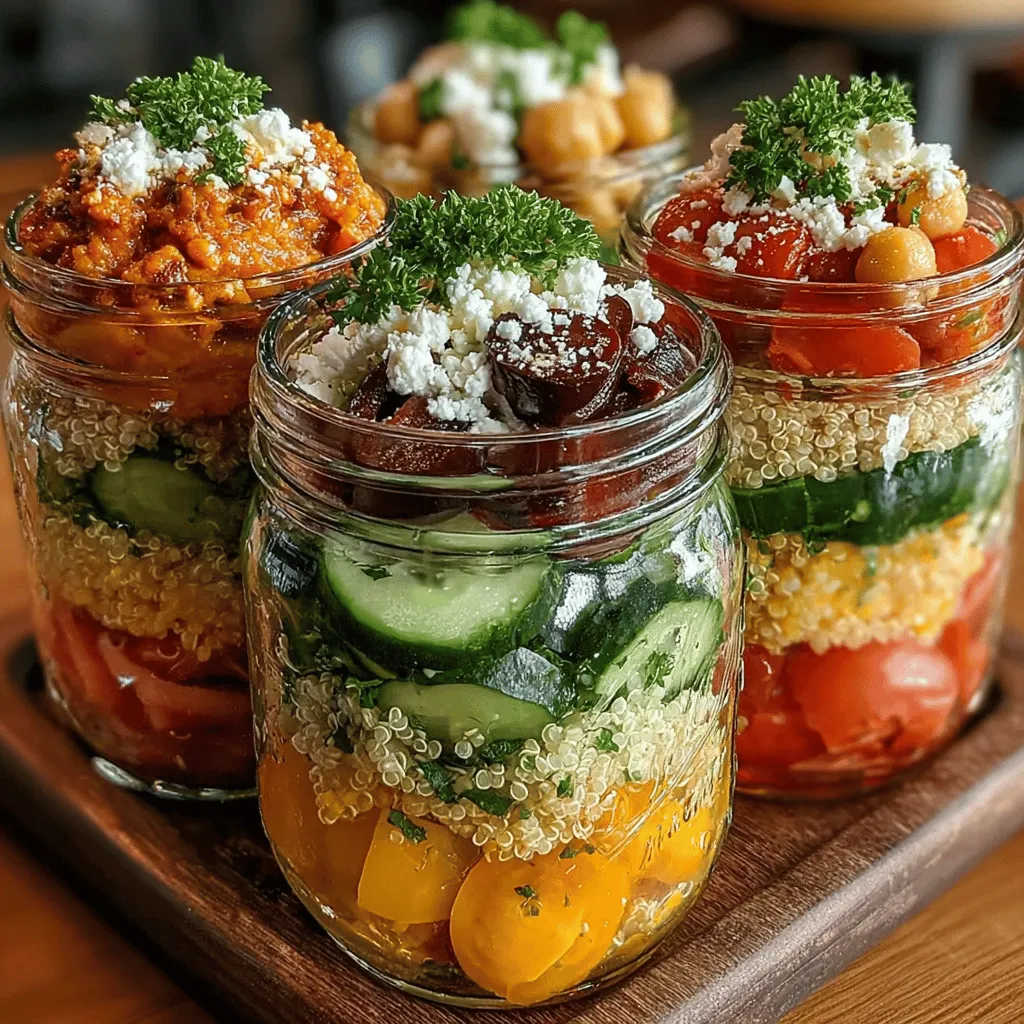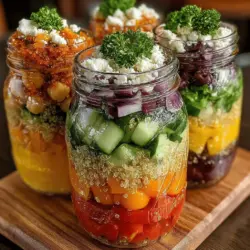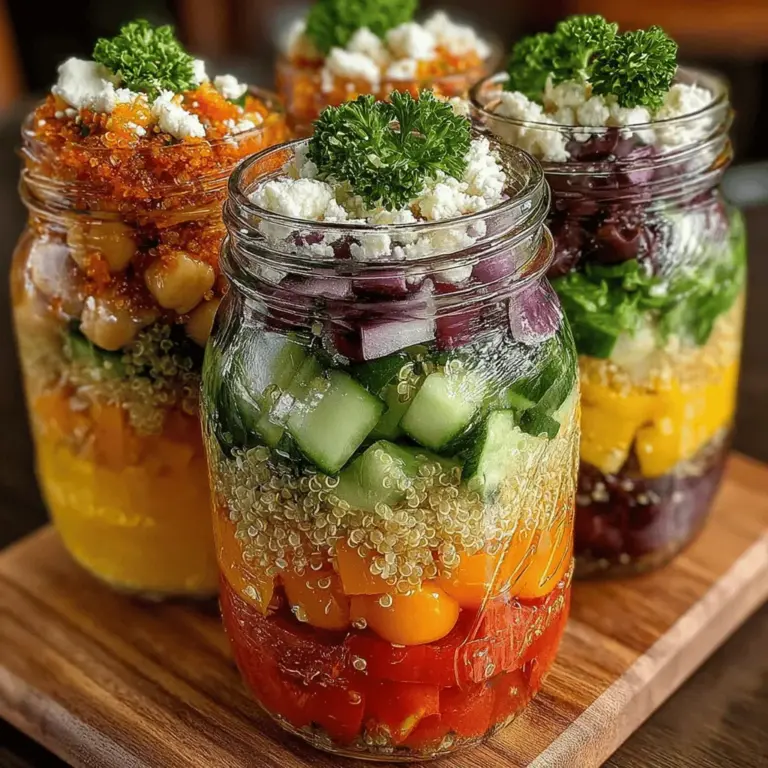Introduction to Layered Mediterranean Salad Jars
Mediterranean cuisine is renowned for its vibrant flavors, fresh ingredients, and health-promoting properties. Rooted in the culinary traditions of countries surrounding the Mediterranean Sea, this style of cooking emphasizes the use of olive oil, whole grains, vegetables, legumes, and lean proteins, contributing to a balanced and nutritious diet. Studies have shown that adopting a Mediterranean diet can lead to numerous health benefits, including reduced risk of heart disease, improved metabolic health, and enhanced longevity.
In today’s fast-paced world, the need for convenient yet healthy meal options has never been greater. Meal prepping has gained popularity as an effective strategy for maintaining a balanced diet amidst busy lifestyles. Among the myriad of meal prep ideas, salad jars stand out as a modern solution that combines convenience with nutrition. Layered Mediterranean salad jars not only look appealing but also allow for a delightful medley of flavors and textures that remain fresh and crisp.
Understanding the Ingredients
At the core of a delicious layered Mediterranean salad jar are its fresh and wholesome ingredients. Each component not only adds flavor but also contributes to the overall nutritional profile of the dish.
Quinoa serves as an excellent base for these salad jars. Often dubbed a superfood, quinoa is a complete protein, meaning it contains all nine essential amino acids. It is also high in fiber, iron, and magnesium, making it a perfect addition for those seeking plant-based meal options. The nutty flavor of quinoa pairs well with the other ingredients, providing a hearty foundation for the salad.
Chickpeas are another vital ingredient, providing a substantial source of plant-based protein and fiber. These legumes are not only filling but also packed with essential nutrients like folate and manganese. Their slightly nutty flavor complements the medley of vegetables and adds a satisfying texture to the salad.
Fresh vegetables are the stars of this dish. Cherry tomatoes, cucumbers, bell peppers, and red onions offer a rainbow of colors and a variety of textures that make each bite exciting. Cherry tomatoes are juicy and sweet, cucumbers are crisp and refreshing, bell peppers add a slight crunch, and red onions introduce a sharp bite that balances the other flavors.
For a salty, briny punch, Kalamata olives and feta cheese are included in the mix. Kalamata olives boast a rich flavor that enhances the Mediterranean essence of the salad, while feta cheese adds creaminess and a tangy flavor. Both ingredients elevate the overall taste profile, making the salad both satisfying and delicious.
Fresh parsley not only adds a burst of green but also brings a fresh, earthy flavor that complements the other ingredients. It is also packed with antioxidants, vitamins, and minerals, boosting the nutritional value of the salad. The dressing plays a crucial role in tying all these flavors together, typically featuring olive oil, lemon juice, garlic, and herbs, which are staples in Mediterranean cooking.
Preparation of Layered Mediterranean Salad Jars
Creating Layered Mediterranean Salad Jars is a straightforward process that allows for creativity and personalization. Here’s a step-by-step breakdown of the preparation process:
1. Prepare the Quinoa: Start by rinsing 1 cup of quinoa under cold water to remove any bitterness. Cook it according to package instructions, typically using a 2:1 ratio of water to quinoa. Bring the water to a boil, add the quinoa, and then reduce to a simmer, covering the pot. Allow it to cook for about 15 minutes or until the water is absorbed. Once cooked, fluff it with a fork and let it cool.
2. Make the Dressing: The dressing is a crucial component that enhances the flavors of the salad. In a small bowl, whisk together 1/4 cup of extra virgin olive oil, the juice of one lemon, one minced garlic clove, and a pinch of salt and pepper. You can also add a teaspoon of dried oregano for an extra burst of Mediterranean flavor. Adjust the seasoning according to your taste, then set it aside.
3. Chop the Vegetables: While the quinoa is cooling, chop the fresh vegetables. Halve the cherry tomatoes, dice the cucumbers, chop the bell peppers into bite-sized pieces, and finely slice the red onions. Ensure that the pieces are small enough to fit comfortably in the jar while allowing for even distribution of flavors.
4. Prepare the Chickpeas and Olives: If using canned chickpeas, drain and rinse them under cold water. For the olives, pit and slice them if they are not pre-sliced. Crumble the feta cheese into bite-sized pieces.
5. Layer the Ingredients: The key to a perfect salad jar is the layering technique, which not only looks appealing but also helps maintain the freshness of each ingredient. Start by adding the dressing at the bottom of the jar. Follow with the quinoa, creating a solid base that will absorb some of the dressing and prevent sogginess. Next, layer the chickpeas and then add the chopped vegetables, layering them in the order of their moisture content, with the drier ingredients on top. Finish with the Kalamata olives, feta cheese, and a sprinkle of parsley to garnish.
Layering Techniques for Salad Jars
Layering is essential for ensuring that your salad stays fresh and retains its flavors until you’re ready to eat. By understanding the significance of each layer, you can create a balanced and visually appealing dish.
Starting with quinoa as the base layer is crucial. It acts as a barrier between the dressing and the vegetables, absorbing flavor without becoming soggy. This layer is not only filling but also provides a hearty texture that complements the other ingredients.
Next, the chickpeas should follow. Their density helps to keep the lighter ingredients, such as vegetables, from getting crushed. After the chickpeas, it’s time to add the fresh vegetables. By layering the drier ingredients first, you help prevent moisture from the tomatoes and cucumbers from affecting the integrity of the quinoa and chickpeas.
The olives and feta cheese should be placed on top, as these ingredients can withstand sitting above the moisture-rich vegetables for a few days without losing their texture. The final garnish of parsley adds a fresh pop of color and flavor, making the salad jars visually appealing and ready to impress when you open them.
By following these steps, you can create Layered Mediterranean Salad Jars that not only taste delicious but also offer an array of health benefits, making them a perfect addition to your meal prep routine. The vibrant colors and fresh ingredients will make you excited to enjoy a healthy meal, whether at home or on the go.

Tips for Maintaining Texture and Taste in Jar Salads
Creating the perfect layered Mediterranean salad jar requires a balance of flavors and textures. Here are some essential tips to ensure that your salad remains fresh and delicious:
1. Layering Order Matters: Start with the dressing at the bottom of the jar, followed by hearty vegetables like cucumbers and bell peppers, then grains, proteins, and finally, leafy greens on top. This prevents the greens from wilting and keeps them crisp.
2. Choose Stable Ingredients: Incorporate sturdy ingredients that can withstand being in the jar without losing their texture. Items like cherry tomatoes, bell peppers, and cucumbers maintain their crunchiness. Soft ingredients, such as avocados or lettuce, should be added last to avoid mushiness.
3. Dress Just Before Eating: For optimal freshness, consider storing your dressing separately and adding it just before consumption. This preserves the texture of the ingredients and prevents sogginess.
4. Avoid Overpacking: While it may be tempting to fill the jar to the brim, leaving a little space allows for some movement. This can prevent squishing and help maintain the salad’s fresh appearance.
5. Use Airtight Containers: Ensure that your salad jars are tightly sealed to keep the ingredients fresh. Glass jars with airtight lids or high-quality plastic containers work best for this purpose.
Serving and Enjoying Your Salad Jars
Suggestions for When to Add Dressing for Optimal Freshness
To maintain the salad’s freshness, it’s best to add the dressing just before you plan to eat. If you pre-dress your salad, the greens can become wilted and the overall texture compromised. When you’re ready to enjoy your salad jar, simply shake it well after adding the dressing to distribute the flavors evenly. This technique ensures that every bite is as fresh and vibrant as the first.
Ideas for Serving: At Home, Picnics, or Meal Prep for the Week
Layered Mediterranean salad jars are incredibly versatile and can suit various occasions:
– At Home: These jars make for a quick and nutritious lunch or dinner option. Simply grab a jar from the refrigerator, add your dressing, shake, and enjoy.
– Picnics: Perfect for outdoor meals, these jars are easy to transport and serve. Just pack a few jars in a cooler with ice packs to keep them chilled. They make a colorful and healthy addition to any picnic spread.
– Meal Prep for the Week: Prepare several jars at once, storing them in the fridge for convenient grab-and-go meals throughout the week. This not only saves time but also ensures you have healthy options readily available.
Discussing the Versatility of Salad Jars for Different Occasions
One of the best aspects of layered salad jars is their versatility. They can be customized for any occasion, whether it be a casual family dinner, a formal gathering, or even a potluck. You can easily switch up the ingredients to match the season or your dietary preferences. For instance, in the summer, you might opt for lighter vegetables and fruits, while in the winter, heartier ingredients like roasted squash or root vegetables can be included.
Nutritional Analysis of Layered Mediterranean Salad Jars
Breakdown of Macronutrients: Protein, Fats, and Carbohydrates Per Jar
The Mediterranean diet is renowned for its health benefits, and this layered salad jar is no exception. Here’s a general breakdown of the macronutrients you can expect per jar:
– Protein: Approximately 15-20 grams, primarily from chickpeas, feta cheese, and any additional proteins like grilled chicken or quinoa.
– Fats: Around 10-15 grams, largely from olive oil, nuts, and cheese, providing healthy sources of fat that are essential for heart health.
– Carbohydrates: Roughly 30-40 grams, mainly from vegetables and grains, providing energy and fiber.
This balance makes the salad jar not only filling but also nutritious, offering a well-rounded meal.
Health Benefits Associated with the Mediterranean Diet
The Mediterranean diet is celebrated for its potential health benefits, including:
– Heart Health: Rich in healthy fats from olive oil, nuts, and fish, this diet can help reduce the risk of heart disease.
– Weight Management: The emphasis on whole foods, fiber-rich ingredients, and balanced macronutrients can support healthy weight loss and maintenance.
– Reduced Inflammation: The inclusion of antioxidants from fruits, vegetables, and whole grains can help reduce inflammation in the body.
Discussion on How This Recipe Can Fit into Various Dietary Plans
Layered Mediterranean salad jars can easily fit into various dietary plans, including vegetarian, vegan, gluten-free, and Mediterranean diets. By adjusting the ingredients, such as using quinoa instead of couscous for a gluten-free option or omitting cheese for a dairy-free version, you can cater to a wide range of dietary needs while still enjoying this delicious salad.
Storage and Shelf Life
How to Properly Store Salad Jars
To maximize the freshness of your salad jars, proper storage is key. Store them upright in the refrigerator, ensuring the lids are tightly sealed. Keep them away from the back of the fridge where temperatures can fluctuate.
Tips on How Long the Jars Stay Fresh in the Refrigerator
Generally, layered salad jars can last up to 4-5 days in the refrigerator. The key is to ensure that the dressing is at the bottom and the greens are at the top, which will help maintain their crispness. If you notice any signs of spoilage, such as off smells or discoloration, it’s best to discard the jar.
Discussion on Potential Modifications and Substitutions to Suit Dietary Needs
Feel free to modify the recipe to suit your taste preferences or dietary restrictions. Here are some ideas:
– For a Vegan Option: Replace cheese with avocado or a sprinkle of nutritional yeast for a cheesy flavor without dairy.
– For Added Protein: Incorporate grilled chicken or turkey for a heartier meal.
– For a Low-Carb Version: Substitute quinoa with cauliflower rice or omit grains altogether.
These modifications make the salad jar a flexible option suitable for everyone.
Conclusion: The Joy of Layered Mediterranean Salad Jars
Layered Mediterranean salad jars are not only visually appealing but also incredibly convenient and healthful. They exemplify the ease of incorporating fresh, nutritious ingredients into your diet while providing a versatile option for various occasions. The ability to customize these jars according to your preferences allows you to experiment with flavors and textures, making healthy eating enjoyable and accessible.
As you try out this recipe, consider branching out with different ingredients and dressings to keep things exciting. The joy of creating layered salad jars lies in their adaptability, so don’t hesitate to explore new combinations. Whether you’re meal prepping for the week, packing a lunch for work, or planning a picnic, these salads are sure to impress. Embrace the Mediterranean lifestyle and enjoy the delicious flavors that come with it!


